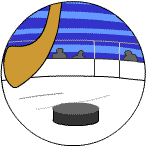Ice Hockey
Created | Updated Nov 14, 2011

Canada claims ice hockey1 as its national sport. That designation goes officially to lacrosse, but since hardly anyone actually plays lacrosse, the country, by unspoken consensus, has come to regard hockey as holy.
A sport very similar to football ('soccer' in the States, or 'way of life' everywhere else), except for the ice, sticks, puck, equipment and the fact that the players do the fighting instead of the fans. In fact, almost everything in hockey is different from football, other than the object of the game, which is to score more goals than your opponent.
Goals are scored by moving a small round black disc ('puck' or 'biscuit' or 'rubber' or 'small flying bullet of death') into a semi-rounded cage with metal bars and netting ('net'). The puck must be shot into the net using a long wooden stick with a curved end (yet another example of the usefulness of the stick).
The unspoken objective, obvious to the casual viewer, is to drive the opposing players out of the field of play by means of bodily contact. This seems like a reasonable aim until you realise that the playing surface is surrounded by a four foot wall topped with up to eight feet of unbreakable Plexiglas2.
Six players are on the playing surface ('ice', or in the southern US, 'lake') for each team at any one time. Of the six, the most important is the player who keeps the puck out of the net ('goalie' or 'primary target'). Besides the goalie, there are two players who help the goalie keep the puck out of the net ('defencemen' or 'secondary targets'), and three players who try to put the puck in the opposing team's net (one 'centre' and two 'forwards', or 'egomaniacs'). To add to the confusion, the defencemen are expected to help the centre and forwards put the puck in the opposing net, while the centre and forwards are expected to help the defencemen keep the puck out of their own net. Because the defencemen, centre, and forwards are so busy helping each other, they often end up resenting the goalie, who helps no one and spends half the game standing around waiting for a chance to stop the puck from going into the net.
The other participants in the game ('referees' and 'linesmen', or 'blind jerks', or even 'punching bags') make sure everyone plays by the rules. The referees have the option of punishing players who violate certain rules, in which case they will call a penalty. A player who has drawn a penalty will be sent to a glass box ('penalty box' or 'sin bin' or 'public viewing chamber') so that all the fans, as well as the other players, can see what a bad person that player has been. The linesmen, who have flunked out of referee school and thus may not call penalties, spend most of their time watching two blue lines on the ice, as well as breaking up fights by sticking their faces in front of the player's fists.
There are many rules that must be followed, most of which are designed to keep the players from hurting each other so badly that they cannot play in the next game. However, they must hurt each other enough to keep the fans interested. Players must never, ever swing their sticks at another player, unless the referee (blind jerk) is not looking. Players who wish to fight each other must first discard all hats, gloves, sticks, and good-luck charms to prevent either player from gaining an unfair advantage, and must eventually invite the linesmen (punching bags) over to take the majority of the damage. The goalie is not allowed to fight, primarily because the sight of a goalie fighting in full equipment can lead to various laughter-related injuries to the fans.
A goalie who is caught breaking the rules does not go to the penalty box. Instead, the decision-maker of the team ('coach' or 'babysitter') picks a centre, forward, or defenceman to serve the penalty, so that the goalie can continue to keep pucks out of the net and break the rules whenever the referee is not looking. This has only served to increase the resentment of the centres, forwards, and defencemen, who cannot understand why the goalie should not also be publicly humiliated.

